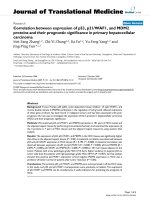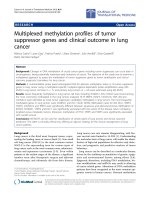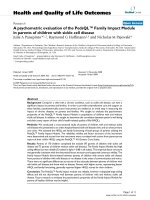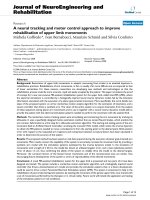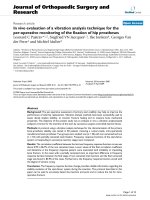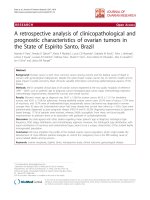Báo cáo hóa học: " A retrospective evaluation of the impact of a dedicated obstetric and neonatal transport service on transport times within an urban setting" pptx
Bạn đang xem bản rút gọn của tài liệu. Xem và tải ngay bản đầy đủ của tài liệu tại đây (183.93 KB, 6 trang )
ORIGINAL RESEARCH Open Access
A retrospective evaluation of the impact of a
dedicated obstetric and neonatal transport
service on transport times within an urban
setting
Shaheem De Vries
*
, Lee A Wallis and David Maritz
Abstract
Objective: To determine whether the establishment of a dedicated obstetric and neonatal flying squad resulted in
improved performance within the setting of a major metropolitan area.
Design and Setting: The Cape Town metropolitan service of the Emergency Medical Services was selected for a
retrospective review of the transit times for the newly implemented Flying Squad programme. Data were imported
from the Computer Aided Dispatch programme. Dispatch, Response, Mean Transit and Total Pre-h ospital times
relating to the obstetric and neonatal incidents was analysed for 2005 and 2008.
Results: There was a significa nt improvement between 2005 and 2008 in all incidents evaluated. Flying Squad
dispatch performance improved from 11.7% to 46.6% of all incidents dispatched within 4 min (p < 0.0001).
Response time performance at the 15-min threshold did not demonstrate a statistically significant improvement
(p = 0.4), although the improvement in the 30-min performance category was statistically significant in both
maternity and neonatal incidents. Maternity incidents displayed the greatest improvement with the 30-min
performance increasing from 30.3% to 72.9%. The analysis of the mean transit times demonstrated that neonatal
transfers displayed the longest status time in all but one of the categories. Even so, the introduction of the Flying
Squad programme resulted in a reduction in a total pre-hospital time from 177 to 128 min.
Conclusion: The introduction of the Flying Squad prog ramme has resul ted in significant improvement in the
transit times of both neonatal and obstetric patients. In spite of the severe resource constraints facing devel oping
nations, the model employed offers significant gains.
Introduction
Maternal and child health is one of the main focusses of
the World Health Organisation’s Millennium Develop-
ment Goals. These have formed the basis of national
strategic initiatives of both Government and Non-Gov-
ernmental Organisations [1]. In this regard, many of the
initiatives in the South African health context have lar-
gely focussed on hospitals or primary health care, how-
ever, very little attention has focussed on the impact of
Emergency Medical Services (EMS) achieving these
goals.
METRO EMS is a state run ambulance service provid-
ing essential pre-hospital emergency care to the popula-
tion of the Western Cape of South Africa. It serves a
total area of 129,526 km
2
with an estimated total popu-
lation of 5,400,000 people [2]. METRO EMS is tasked
with the provision of on-scene emergency care and
essential medical rescue services, and has a duty to
respond to all incidents received by the emergency con-
trol centre. The Western Cape has a tiered health care
model with different hospital packages of care o ffered at
level one (d istrict), two (regional) and three (central).
The Community Perinatal Service within the Western
Cape has at its core the concept of a regionalised peri-
natal service that ensures that all births occur within a
* Correspondence:
Division of Emergency Medicine, University of Cape Town and Stellenbosch
University, Cape Town, South Africa
De Vries et al. International Journal of Emergency Medicine 2011, 4:28
/>© 2011 De Vries et al; licensee Springer. This is an Open Access article distributed under the terms of the Creative Commons
Attribution License ( which permits unrestricted use, distributio n, and repro duction in
any medium, provided the original work is properly cited.
health facility [2]. Health, social and infrastructure pro-
blems of a mixed developed and developing world result
in a very high demand for EMS inter-facility transfers.
METRO EMS is assessed against a 15-min response
time target for metropolitan Priority One calls a nd a 40-
min target for rural Priority One calls [3]. Within
METRO EMS, the standard of maternal and neonatal
transfers has historically been reported to be poor, with
clinicians expressing high levels of frustra tion at the pro-
longed response times and poorly equipped vehicles [4,5].
The obstetric and neonatal Flying Squad
Prior to 2005, EMS provided an obstetric flying squad
service that was not dedicated, but rather integrated
into the general operational pool of EMS resources.
However, all Flying Squad responses were logged on the
control centre databases as Flying Squad calls. A more
effective way to transport critical or high-risk pregnan-
cies to a specialised unit quickly and efficiently has been
needed for some time, as the previous Flying Squad
Obstetric Service’s satisfaction and performance ratings
has deteriorated.
With the implementation of a formal METRO EMS
quality assurance programme in 2005, a renewed focus
on the aspects of obstetric and neonatal service was
adopted. In 2006, EMS introduced a dedicated maternal
and neonatal F lying Squad service to address some of
thesefailings.Thepurposeoftheprogrammewasto
provide service excellence in the realm of maternal and
child pre-hospital care [6].
While anecdotally clinician satisfaction has dramati-
cally increased, it is not known whether the Flying Squad
service has made an impact on the way this group of
patients is serviced by EMS. We therefore undertook a
study to evaluate whether the introduction of a dedicated
obstetric and neonatal Flying S quad transfer programme
resulted in greater efficiency and improved response
times within the Cape Town Metropolitan area.
Methods
We undertook a retrospective review of all EMS obste-
tric and neon atal Flying Squad calls during two separate
1-year periods: 1 January - 31 December 2005 (non-
dedicated Flying Squad) and 1 January - 31 December
2008 (new, dedicated Flying Squad).
Inclusion and exclusion
All calls coded for the Flying Squad during the study
period were eligible for inclusion. There were no
exclusions.
Data collection
Data are collected at the METRO EMS Cape Town
Control Centre for every call received and processed in
Cape Town. Data for this study were collected from the
Computer Aided Dispatch programme.
Data analysis
Response times, transit times and mission times for all
maternal and neonatal transfers were examined to estab-
lish performance in the two study periods. A further
comparison was made with the performance of EMS on
all other Priority One calls in the same time periods (to
establish whether any improvement demonstrated may
have been a reflection of the general improvement
achieved within METRO EMS).
Data were extracted into a password-protected Micro-
soft Excel (Microsoft, Redmond, WA) database from the
CAD (Computer-Aided Dispatch) using a Sequel server.
Mean, median, range, standard deviation and 95%
confidence intervals were us ed to describe different data
sets. A p-value ≤ 0.05 was regarded as statistically signif-
icant; a chi-square test was used to compare categorical
data.
A mixed models analysis was employed using SAS
Systems. A repeated-measures ANOVA was used, where
the year was regarded as the repeated measure and the
factor was the variable.
Measured outcomes
Definitions of terms measured are provided in the
Appendix.
Ethical considerations
Ethics approval was granted by the University of Cape
Town.
Results
Call volume
The total number of other P1 calls dispatched in 2005
was 46,074; in the same period, 3,257 Flying Squad inci-
dents were dispatched (6.6% of total P1 calls) (Table 1).
In 2008, 65,885 ‘other P1’ calls were dispatched (43%
increase from 2 005); 4,865 Flying Squad incidents were
dispatched (49.3% increase, 6.9% of all P1 calls).
Dispatch
In 2005, 11.7% of Flying Squad calls were dispatched
within 4 min and 31.9% within 10 min (Table 2). This
performance is still below that recorded for all other P1
calls dispatched in both the ‘under 4 min’ and ‘under 10
min’ categories.
Response
Percentage of incidents responded to was analysed at 15,
30, 40 and 60 min (Table 1). Whilst there was a sub-
stantial improvement in the response performance
achieved by the Flying Squad (p < 0.0001), the
De Vries et al. International Journal of Emergency Medicine 2011, 4:28
/>Page 2 of 6
performance is still below that achieved by the ‘all other
P1’ category.
Mean status times
Due to missing data elemen ts for the ’timespentathospital’
category, it was not possible to calculate the Mean Mission
Time for both 2005 and 2 008. Instead, ‘time until arrival at
the hospital’ was used as a reflection of the mission time
(referred t o in this study as ‘total pre-ho sp ita l’ time.)
In 2005, the total pre-hospital time for P1 neonatal
transfers was the longest at a me an of 298 min (Table 3).
This was more than twice the m ean recorded for ’ all
other P1’ incidents in that same ye ar. Neonatal transfers
therefore spent longer in a particular status category than
in any of the other categories. This trend was seen in all
but one of the status categories (mean ’to hospital’ time).
The time ’to dispatch’ was also significant with a mean
of 78 min, which was nearly more than double that of
P1 maternity incidents and nearly four times that
recorded for ‘all other’ incidents. In 2005, ’all other’
calls displayed the most efficient performance with the
lowest mean time recorded in nearly all status cate-
gories. P1 maternity incidents were the next best perfor-
mer with a mean ‘total pre-hospital’ time of 98 min.
In 2008, performance was substantially improved
across all categories, with improved mean ‘pre-hospit al’
times recorded for all incidents. The greatest change
was observed in the P1 neonatal incidents that improved
from a mean total pre-hospital time of 177 min in 2005
to 128 min in 2008. This w as achieved despite a two-
fold increase in call volume. The greatest performan ce
improvement for the P1 neonatal incidents can be seen
in the mean time to dispatch, which was substantially
reduced from 78 min in 2005 to 22 min in 2008. How-
ever, P1 neonatal transfers still recorded the longest
mean status times in most of the status categories.
P1 maternity incidents improved from a mean ’total
pre-hospital’ time of 98 min in 2005 to 79 min in 2008.
Significant in this improvement is the mean time
recorded to dispatch the incident. This improved from
32 min in 2005 to 10 min in 2008, which was the lowest
time recorded for all the categories. Inter-facility trans-
fers recorded the worst dispatch performance with the
mean time ‘to dispatch’ recorded as 35 min in 2008. ‘All
other’ incidents recorded the best overall performance
with a mean ‘total pre-hospital’ time of 67 min. The
reduction in time spent through the life cycle of a call is
clear. This is still substantially above the service target of
45 min, indicating the continued need for improvement.
Discussion
For the purposes of this study, improvement was
defined as having completed incidents in terms of pro-
cess measures, i.e., a measure of the time expended dur-
ing the execution of the call. Particular focus was placed
on what are regarded by METRO EMS as t he most
important indicators: dispatch, response and mission
times. The results indicate that between 2005 and 2008,
the service had made significant improvements in its
performance across all incident categories as is reflected
by the improvement in the ‘all other P1’ categories.
The reason for this performance is likely to be found
in the improved resources b oth in terms of staffing and
of equipment. In addition, general improvements in
operational structures, management capacity and per-
sonnel management may have contributed to this
improvement. Improvements observed in the general
ambulance operations may also reflect improvement
throughout the health system as a whole. Notwithstand-
ing, the introduction of the Flying Squad programme
has resulted in significant improvements in the perfor-
mance of obstetric and neonatal incidents.
The strategy
The process adopted in the introduction of the Flying
Squad model is significant for understanding its success.
The engagemen t of key stakeholders early on, as well as
their continued involvement throughout the implemen-
tation and evaluation phase, was crucial [6]. Therefore,
ownership of the programme was ensured and facilita-
tion of meeting its principle objectives would be the
responsibility of all involved.
Dispatch
It is in the analysis of the findings concerning the dispatch
that the greatest impact of the Flying Squad programme is
Table 1 Response time performance at 15-, 30-, 40- and 60-min intervals by case type per year
Response count % Response within 15 % Response within 30 % Response within 40 % Response within 60
2005 Maternity/neonate 3,257 6.1 27.8 42.8 63.2
All other P1 46,074 15.5 50.0 64.6 80.9
2008 Flying Squad 4,865 13.2 65.1 79.0 91.6
All other P1 65,885 24.4 67.8 80.7 92.3
Table 2 Comparison of 2005 and 2008 dispatch times
2005 2008 P value
Dispatched within 4 min 11.7% 46.6% < 0.0001
Dispatched within 10 min 31.9% 79.3% < 0.0001
De Vries et al. International Journal of Emergency Medicine 2011, 4:28
/>Page 3 of 6
most apparent. The dramatic increase in the percentage of
calls dispatched within 4 min is responsible for the bulk of
the performance improvement.
Another aspect of the process that influences the suc-
cess is that while it focussed on ring fencing of the
ambulance and its staff, it had in fact ring fenced the
dispatch of the resources as well. Efficiency of resource
utilisation is built on the dispatcher’s decision-making
acumen, which in turn is determined by the quality and
the accuracy of the information obtained. By determin-
ing the manner in which an incident is captured and
evaluated (i.e. the development of predetermined criteria
for dispatch), the programme has resulted in a more
accurate and less vague form of communication. The
result is greater dispatcher confidence and more accu-
rate, rapid and appropriate dispatches stemming from
clearly defined triage categories. This is evident in the
substantial improvement in both t he neonatal and
maternity percentages of dispatched incidents in less
than 4 min.
Perhaps one of the key questions that the study raises,
and one that needs to be explored in later studies, is the
question concerning dispatcher bias. The dispatcher,
alone, determines which resource to activate and which
P1 incident to dispatch; using his/her experience and
judgement to prioritise P1 incidents before dispatching
them. It is suggested that in the case of neonatal and
maternity incidents, the fact that these patients are
already accommodated at a health facility has led many
dispatchers to defer their dispatch in favour of a primary
response (such as to a road accident or patient’s home).
Response
Response time was the second process measure that was
examined, and it demonstrat ed a significant improve-
men t across all the incident categories evaluated. While
an improvement was observed in the 15-min response
performance for maternity incidents, the improvement
in the neonatal category was not found to be statistically
significant.
Neonatal transfers achieved a mean response time of
56 min in 2008 (118 min in 2005). The lack of available
benchmarking as well as the vague definition of
response times renders any mea ningful comparison with
times observed in other studies difficult [7]. Whilst both
Kempley et al. and Abdel-Latif have reported median
response times for neonatal transfers of 85 and 75 min
respectively, this cannot be used as a comparison for
performance achieved in this study [8,9]. Both used
‘response time’ as a measure from the initial discussion
with the receiving facility to what they referred to as the
‘first look’. They do however provide an indication of
the time frames involved in executing these transfers.
Neonatal transfers have very specific requirements
where safety is as important as speed of transfer. Specia-
lised equipment is needed in t erms of incubators, trans-
port ventilators, medication and infusion pumps, etc.
[10]. The Advanced Life Support (ALS) skills required
to perform these transfers safely are also in high
demand, further hampering a speedy execution of the
transfer request. This aspect, together with the high
incidence of adverse events, has meant that services
need to adopt a ‘stay and play’ policy when dealing with
these incidents. It is on this basis that the Flying Squad
included in its strategy a differential response for mater-
nity and neonatal incidents. This evolved into the use of
two intermediate life support (ILS) crews to perform the
maternity transfers, while the ALS crew was reserved to
attend to all the neonatal and critical obstetric transfer
requests.
Greater efficiency was not only seen in the dispatch
and response time performance, but is also evident in
the analysis of the mean status times for each of the
case type categories. Most notable is the status time of
the neonatal incidents in which the longest mean ‘on-
scene’ time was observed in both 2005 and 2008. This
occurred despite the significant improvement in
response time perform ance. Kempley et al.andAbdel-
Latif also made this observation in their analysis of
retrieval teams and their performance [8,9]. This is likely
Table 3 Mean status times as expressed in minutes by case type per year
To dispatch (A) To scene (B) Response (A + B) On scene To hospital Total pre-hospital
Maternity (2005) 32 21 53 23 22 98
Maternity (2008) 10 22 32 26 21 79
Neonatal (2005) 78 40 118 39 20 177
Neonatal (2008) 22 34 56 48 24 128
Inter-facility (2005) 58 23 81 33 20 134
Inter-facility (2008) 35 21 56 35 23 114
All other calls (2005) 22 19 41 24 15 80
All other calls (2008) 12 17 29 23 15 67
Service target 4 11 15 20 10 45
De Vries et al. International Journal of Emergency Medicine 2011, 4:28
/>Page 4 of 6
due to the specialised nature of the neonatal calls. In the
Flying Squad programme, this was addressed by cultivat-
ing an appropriate skill set among the crew during their
6-month rotation.
A further initiative was to ensure that each ALS crew
had the necessary equipment to execute the neonatal
transfers. Therefore, ambulances avoided wasti ng time
in an attempt to locate a neonatal ventilator or working
incubator. The allocation of a dedicated ambulance
ensured that vehicle downtime was minimised as the
crew had a greater sense of ownership and therefore
took greater care. These measures ensured greater effi-
ciency and culminated to reduce mean ‘ pre-hospital
time’.
Limitations
Although the study demonstrates a significant improve-
ment in dispatch and response times, the absence of
patient outcome measures has limited the conclusions
that can be made. Teams may have executed these
transfers more efficiently, but the appropriateness of the
dispatch or the quality of the clinical management can-
not be determined. It is therefore not known whether
the introduction of the Flying Squad programme pro-
vided a better level of care (which was one of the pro-
gramme’s key objectives).
Secondly, the Flying Squad programme does not
‘ stack’ calls. This means that when two requests are
received simultaneously, only one is allocated: a second
resource is then utilised from the general a mbulance
operations in order to service the second call. This is
part of the operating procedures for the Flying Squad,
and a measure of its impact on the level of service pro-
vided is desirable. However, the frequency with which
this occurs is not recorded, and therefore the impact
that this has on the improvement in performance can-
not be measured.
A third limitation lies in the failure to determine the
time spent at the hospital during handover. In so doing,
a critical component of the transfer process was ignored.
Therefore, the role that the hospital has to play in
enabling greater efficiency was not examined. However,
during discussions at Flying Squad meetings, clinicians
from referral and receiving facilities anecdotally have
made no change s in standard practices when receiving
these patients.
Furthermore, as this study is a retrospective analysis,
the impact of potential bias on the part of the investiga-
tor cannot be ignored. More research is therefore
required, examining both the process and patient out-
come measures, also focussing on the establishment and
validation of a morbidity and/or mortality score based
on the dispatch criteria of this Flying Squad programme.
Conclusion
The merits of a specialised retrieval team have been well
established and have been met with generalised accep-
tance by health care systems in developed countries.
The question that faces developing nations is whether
or not such a programme has any role to play, taking
into account the significant challenges they face in
terms of struggling health care systems, poorly
resourced services, significant socioeconomic burdens
and poorly developed infrastructure.
The findings in this study indicate that there are signifi-
cant gains to be made by developing countries through
the introduction of specialist retrieval teams. The proof
resides not only in the greater efficiency that it stands to
benefit from, but a lso in understanding the operational
forces that influence performance. This study has not
only quantified the degree of efficiency that can be
achieved, but has also highlighted several key workflow
processes that are integral to performance. The evidence
in support of retrieval teams is beginning to weigh in,
and health care managers in developing countries need
to start considering these programmes as essential com-
ponents of a developing health care system.
Author information
Dr. David Maritz, MBChB: Specialist resident in Emer-
gency Medicine, Division of Emergency Medicine, Uni-
versity of Cape Town and Stellenbosch University,
South Africa.
Prof. Lee Wallis, MD FRCS FCEM: Head of the
Division of Emergency Medicine, University of Cape
Town and Stellenbosch University, South Africa.
Dr. S haheem De Vries, MBChB MPhil (EM):
METRO Emergency Medical Services
Appendix
Definitions of terms
Dispatch: Time ‘to dispatch’ is defined as t he time in
minutes from the receipt of the telephone call until an
ambulance has been assigned to the incident. Percentage
dispatches under 4 min and under 10 min were
compared.
Response: ‘Response’ time is defined as the time in
minutes from receipt of call until the vehicle arrives on
scene. Response time was analysed for response under
15, 30, 40 and 60 min.
Mean status time: This is calculated using the time in
minutes for each of the individual observations and then
calculating the mean. This was reported for each of the
different status modes: times ’to dispatch’ and ’ to scene’,
as well as ’response’ , ’ on-scene’ and ’to hospital’ times.
No value could be determined for the time spent at the
hospital due to missing data.
De Vries et al. International Journal of Emergency Medicine 2011, 4:28
/>Page 5 of 6
Inter-facility transfer: This refers to patient transfers
between health care facilities and includes clinics, Com-
munity Health Centres (CHC) and hospitals.
Authors’ contributions
S. De Vries came up with the study idea, collected the data, and wrote the
first draft. All authors contributed to the final manuscript.
Conflicts of interests
The authors declare that they have no competing interests.
Received: 29 January 2011 Accepted: 14 June 2011
Published: 14 June 2011
References
1. Millennium Development Goals:[ />millennium_development_goals/en/], World Health Organization [Online].
Available: [last accessed 14 July 2010].
2. Provincial Government Western Cape, Department of Health: Annual
Performance Plan 2009/10 .
3. Provincial Government Western Cape, Department of Health: Comprehensive
service plan for the implementation of health care 2010 2007.
4. Hatherhill M, Waggie Z, Reynolds L, Argent A: Transport of critically ill
children in a resource-limited setting. Intensive Care Med 2003,
29:1547-1554.
5. Scribante J, Bhagwanjee S: National audit of critical care resources in
South Africa - transfer of critically ill patients. SAMJ 2007,
97(12):1323-1326.
6. Provincial Government Western Cape, Department of Health: Flying Squad
Policy 2006.
7. Ramnarayan P: Measuring the performance of an inter-hospital transport
service. Arch Dis Child , Published online 27 Jan 2009;.
8. Kempley S, Baki Y, Ratnavel N, Cavazonni E, Reyes T: Effect of a centralised
transfer service on the characteristics of inter-hospital neonatal transfers.
Arch Dis Child Fetal Neonatal Ed 2007, 92:F185-F188.
9. Abdel-Latif M, Berry A: Analysis of the retrieval times of a centralised
transport service, New South Wales, Australia. Arch Dis Child 2009,
94:282-286.
10. Fenton A, Leslie A, Skeoch C: Optimising neonatal transfer. Arch Dis Child
Fetal Neonatal Ed 2004, 89:F215-F219.
doi:10.1186/1865-1380-4-28
Cite this article as: De Vries et al.: A retrospective evaluation of the
impact of a dedicated obstetric and neonatal transport service on
transport times within an urban setting. International Journal of
Emergency Medicine 2011 4:28.
Submit your manuscript to a
journal and benefi t from:
7 Convenient online submission
7 Rigorous peer review
7 Immediate publication on acceptance
7 Open access: articles freely available online
7 High visibility within the fi eld
7 Retaining the copyright to your article
Submit your next manuscript at 7 springeropen.com
De Vries et al. International Journal of Emergency Medicine 2011, 4:28
/>Page 6 of 6
